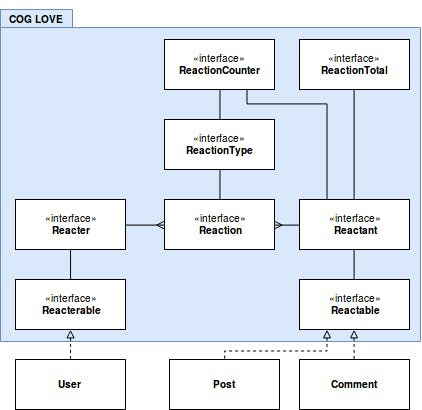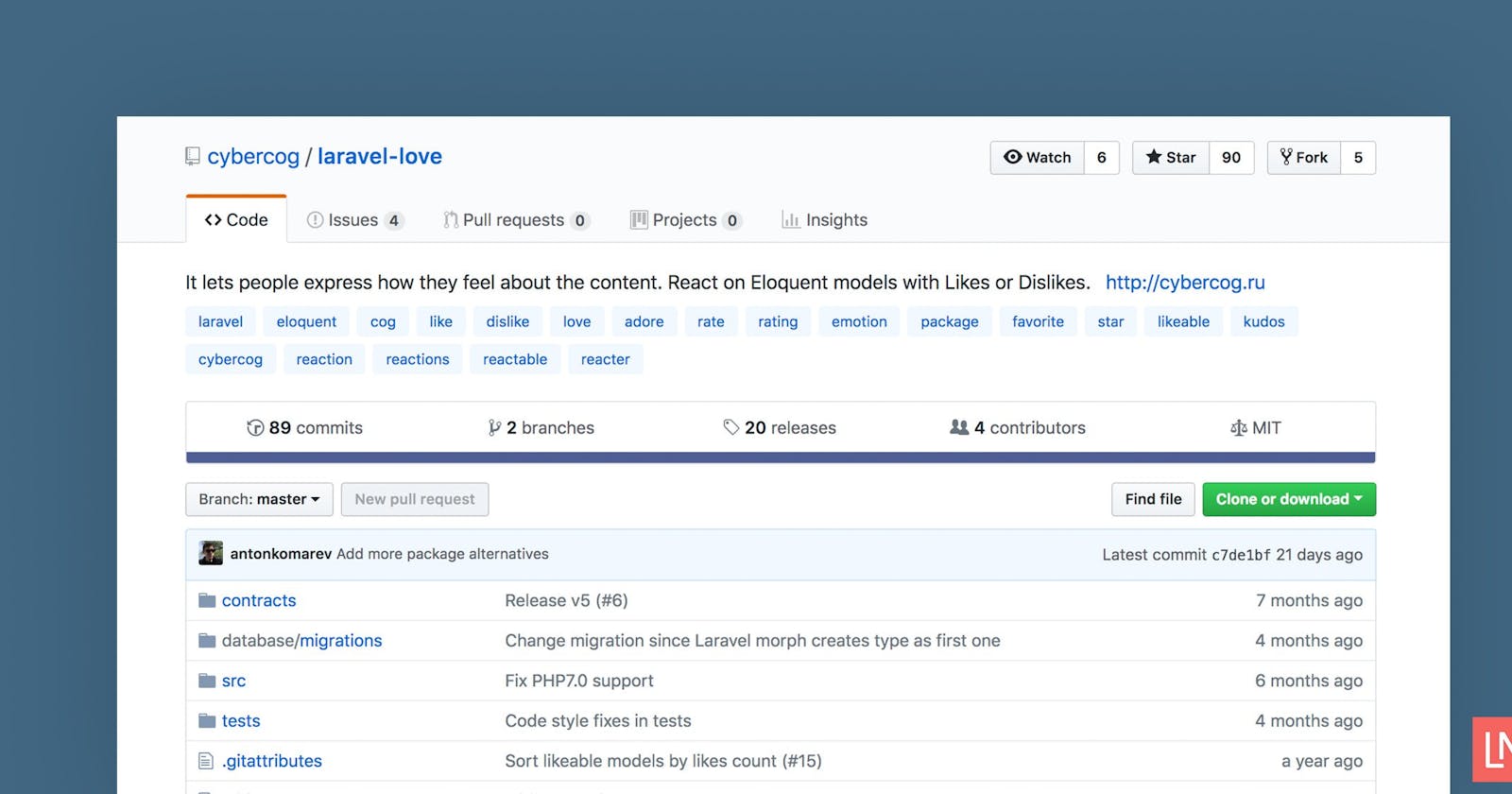Laravel Love is the emotional part of the application. It lets people express how they feel about the content. Make any model reachable in minutes!
There are many different implementations in modern applications:
GitHub Reactions
Facebook Reactions
YouTube Likes
Slack Reactions
Reddit Votes
Medium Claps
Disqus Reactions
This package was developed with the mind that it should cover all the possible use cases and be viable in enterprise applications.
Features
Fully customizable types of reactions.
Any model can react to models and receive reactions at the same time.
Reactants can have many types of reactions.
Reacter can add many reactions to one reactant.
Reacter can react with custom float rate value.
Reaction counters with detailed aggregated data for each reactant.
Reaction totals with total aggregated data for each reactant.
Works with any database
idcolumn type.Sort retractable models by reaction type count.
Sort retractable models by reaction total count.
Sort retractable models by reaction total weight.
Events for added & removed reactions.
Artisan command
love:recount {model?} {type?}to re-fetch reaction stats.Artisan command
love:reaction-type-addto add reaction types.Artisan command
love:setup-reacterableto register Reacterable models.Artisan command
love:setup-reactableto write Reactable models.Customizable database storage.
System Design

Glossary
Reaction — the response that reveals Reacter's feelings or attitude to the Reactant.
Reacter — one who reacts.
Reacterable — model which can act as Reacter on the application level.
Example: User, Person, Organization, etc
Reactant — subject which could receive Reactions.
Reactable — model which can act as Reactant on the application level.
Example: Post, Comment, User, etc
ReactionType — type of the emotional response.
Example: Like, Dislike, Love, Sad, etc
Reaction Rate — the velocity of an reactant becoming popular.
ReactionType Mass — amount of weight added to the Reaction.
Reaction Weight — ReactionType Mass * Reaction Rate.
ReactionCounter — aggregated statistical values of ReactionTypes related to the Reactant.
ReactionTotal — aggregated statistical values of total reactions count & their weight related to the Reactant.
Database Schema

Implementation Highlights
Frameworks Integration
- Designed to work with Laravel Eloquent models.
Code Concepts
Strict typed code.
Using Null Object design pattern instead of
nullvalues.Non extendable classes declared as final.
Using contracts to keep high customization capabilities.
Using traits to get functionality out of the box.
Throws only custom exceptions with
LoveThrowableinterface.Using Facade design pattern to expose simpler high-level API.
Database
Using database foreign keys to keep data integrity.
All database tables have
love_prefix.
Testing
- Covered with PHPUnit tests.
Follows PHP Standard Recommendations
System Requirements
Laravel Love has a few requirements you should be aware of before installing:
PHP 8+
Laravel Framework 9+
Installation Instructions
Pull in the package through Composer.
composer require cybercog/laravel-love
Run database migrations.
php artisan migrate
Manage Reaction Types
Reaction type required to react to content.
Create a list of default reaction types (Like & Dislike) or create your own build!
Add Default Types
php artisan love:reaction-type-add --default
In Artisan execute love:reaction-type-add command with --default flag to add Like and Dislike types to application. Reactant's total mass increments +1 with each Like and decrements -1 with Dislike.
📘 If any of
LikeorDisliketypes already exists in application - command will add only missing one.
Add Custom Type
php artisan love:reaction-type-add
📘Type names transformed to StudlyCase.
Namevery-goodwill be converted toVeryGood.
Pass name & mass arguments in command line to skip interaction.
php artisan love:reaction-type-add --name=Hate --mass=-4
Setup Reacterable
User model cannot directly react to the content. It should delegate this job to related Reacter model.
Code Changes
Declare that model implements
Cog\Contracts\Love\Reacterable\Models\Reacterablecontract.Use
Cog\Laravel\Love\Reacterable\Models\Traits\Reacterabletrait or implement each method of the contract by yourself.
As result you will have:
<?php
namespace App\Models;
use Cog\Contracts\Love\Reacterable\Models\Reacterable as ReacterableInterface;
use Cog\Laravel\Love\Reacterable\Models\Traits\Reacterable;
use Illuminate\Foundation\Auth\User as Authenticatable;
class User extends Authenticatable implements ReacterableInterface
{
use Reacterable;
}
Database Changes
- Run set up reacterable command.
php artisan love:setup-reacterable --model="App\Models\User"
📘Add
--nullableflag if all models of this type must NOT be reacterable:
$ php artisan love:setup-reacterable --model="App\Models\User" --nullable
📘Manual migration creation described in Custom Setup Migrations.
- Run migration.
php artisan migrate
Creating Reacter Models
If you are integrating package on already existing user base you need to register your Reacterable models as Reacters.
php artisan love:register-reacters --model="App\Models\User"
This command will create Reacter model for each User model.
Setup Reactable
Comment model cannot receive reactions directly. It should delegate this job to related Reactant model.
Add Reactable interface & trait to your Comment model code and run artisan setup command to make a link with Reactant model.
Code Changes
Declare that model implements
Cog\Contracts\Love\Reactable\Models\Reactablecontract.Use
Cog\Laravel\Love\Reactable\Models\Traits\Reactabletrait or implement each method of the contract by yourself.
As result you will have:
PHP
<?php
namespace App\Models;
use Cog\Contracts\Love\Reactable\Models\Reactable as ReactableInterface;
use Cog\Laravel\Love\Reactable\Models\Traits\Reactable;
use Illuminate\Database\Eloquent\Model;
class Comment extends Model implements ReactableInterface
{
use Reactable;
}
Database Changes
- Run set up reactable command.
php artisan love:setup-reactable --model="App\Models\Comment"
📘 Add
--nullableflag if all models of this type must NOT be reactable:
php artisan love:setup-reactable --model="App\Models\Comment" --nullable
📘 Manual migration creation described in Custom Setup Migrations.
- Run migration.
php artisan migrate
Creating Reactant Models
If you are integrating package on already existing user base you need to register your Reactable models as Reactants.
php artisan love:register-reactants --model="App\Models\Comment"
This command will create Reactant model for each Comment model.
